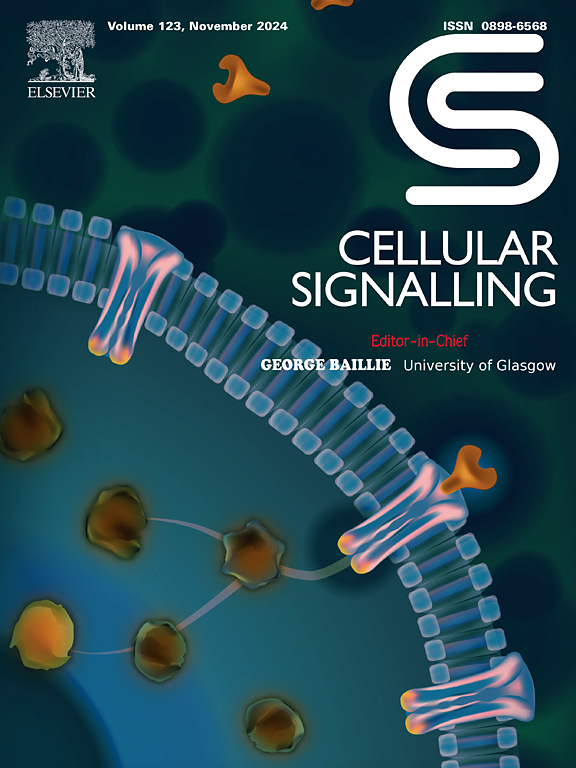Function of intramitochondrial melatonin and its association with Warburg metabolism
IF 4.4
2区 生物学
Q2 CELL BIOLOGY
引用次数: 0
Abstract
Warburg metabolism (aerobic glycolysis) is accompanied by high mitochondrial reactive oxygen species (ROS) generation from the electron transport chain; this is a “Hallmark of Cancer”. The elevated ROS sustain the growth and proliferation of the cancer cells. Melatonin is a potent and functionally diverse free radical scavenger and antioxidant that is synthesized in the mitochondria of non-pathological cells and normally aids in keeping mitochondrial ROS levels low and in maintaining redox homeostasis. Because the glucose metabolite, pyruvate, does not enter mitochondria of Warburg metabolizing cells due to the inhibition of pyruvate dehydrogenase complex (PDH), acetyl coenzyme A production is diminished. Acetyl coenzyme A is a necessary co-substrate with serotonin for melatonin synthesis; thus, intramitochondrial melatonin levels become reduced in cancer cells. The hypothesis is that the depressed melatonin levels initiate aerobic glycolysis and allow the exaggerated ROS concentrations to go uncontested; the authors speculate that the elevated mtROS upregulates hypoxia inducible factor 1α (HIF-1α)/pyruvate dehydrogenase kinase (PDK) axis which inhibits PDH, thereby supporting cancer cell proliferation and stimulating cancer biomass. Exposing Warburg metabolizing cancer cells to melatonin elevates intramitochondrial melatonin, thereby reducing mtROS and concurrently interrupting aerobic glycolysis and inhibiting tumor cell proliferation. Mechanistically, higher mitochondrial melatonin levels by supplementation directly upregulates the sirtuin 3 (SIRT3)/FOXO/PDH axis, allowing pyruvate entry into mitochondria and enhancing intrinsic mitochondrial melatonin production as in non-pathological cells. Additionally, melatonin inhibits HIF1α, thereby decreasing PDK activity and disinhibiting PDH, so pyruvate enters mitochondria and is metabolized to acetyl coenzyme A, resulting in reversal of Warburg metabolism.
线粒体内褪黑素的功能及其与Warburg代谢的关系
Warburg代谢(有氧糖酵解)伴随着来自电子传递链的高线粒体活性氧(ROS)生成;这是“癌症的标志”。升高的活性氧维持癌细胞的生长和增殖。褪黑素是一种有效的、功能多样的自由基清除剂和抗氧化剂,在非病理细胞的线粒体中合成,通常有助于保持线粒体ROS水平低,维持氧化还原稳态。由于丙酮酸脱氢酶复合物(pyruvate dehydrogenase complex, PDH)的抑制,葡萄糖代谢物丙酮酸不能进入Warburg代谢细胞的线粒体,乙酰辅酶A的产生减少。乙酰辅酶A是合成褪黑素必需的共底物;因此,癌细胞的线粒体内褪黑激素水平降低。假设是褪黑激素水平下降启动有氧糖酵解,并允许过度的ROS浓度不受竞争;作者推测,升高的mtROS上调缺氧诱导因子1α (HIF-1α)/丙酮酸脱氢酶激酶(PDK)轴,抑制PDH,从而支持癌细胞增殖和刺激肿瘤生物量。将Warburg代谢的癌细胞暴露于褪黑激素中会升高线粒体内褪黑激素,从而降低mtROS,同时中断有氧糖酵解并抑制肿瘤细胞增殖。在机制上,通过补充更高的线粒体褪黑激素水平直接上调sirtuin 3 (SIRT3)/FOXO/PDH轴,允许丙酮酸进入线粒体,并增强线粒体内在褪黑激素的产生,就像在非病理细胞中一样。另外,褪黑激素抑制HIF1α,从而降低PDK活性,解除对PDH的抑制,因此丙酮酸进入线粒体代谢为乙酰辅酶A,导致Warburg代谢逆转。
本文章由计算机程序翻译,如有差异,请以英文原文为准。
求助全文
约1分钟内获得全文
求助全文
来源期刊

Cellular signalling
生物-细胞生物学
CiteScore
8.40
自引率
0.00%
发文量
250
审稿时长
27 days
期刊介绍:
Cellular Signalling publishes original research describing fundamental and clinical findings on the mechanisms, actions and structural components of cellular signalling systems in vitro and in vivo.
Cellular Signalling aims at full length research papers defining signalling systems ranging from microorganisms to cells, tissues and higher organisms.
 求助内容:
求助内容: 应助结果提醒方式:
应助结果提醒方式:


